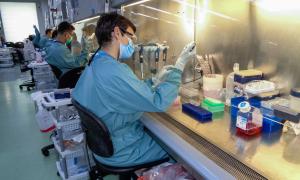SARS-CoV-2 can infect and spread better thanks to lectins, molecules present in immune system cells

The Nature journal publishes an international study, in which IrsiCaixa and IRTA-CReSA have participated, which demonstrates that lectins –molecules present in some cells of the immune system– promote SARS-CoV-2 infection by helping the virus to enter target cells
The IrsiCaixa AIDS Research Institute –a center jointly promoted by the "la Caixa" Foundation and the Department of Health of the Generalitat de Catalunya– and the Animal Health Research Center (CReSA) of the Institute of Agrifood Research and Technology (IRTA) have participated in an international study that demonstrates the influence of lectins –molecules present in the membrane of some immune system cells– on the entry of SARS-CoV-2 into target cells and, therefore, in the dissemination of the infection caused by this virus. The study, published in the Nature journal and led by the Vir Biotechnology research center in San Francisco, reveals one of the mechanisms used by this coronavirus to infect the respiratory tract more easily. In parallel, the results suggest that lectins can also modulate the ability of antibodies to block the virus and thus prevent infection, a fact that should be considered when designing future therapeutic strategies with monoclonal antibodies.
In order to infect, SARS-CoV-2 must bind to a protein located on the outside of the host cell. This protein, called ACE2, acts as a receptor for the virus and is what allows it to enter the cell. "The paradox is that ACE2 is poorly present in the cells of the respiratory tract and yet these are the cells that are most infected by the virus. This tells us that there must be other mechanisms that are facilitating infection in these areas", explains Nuria Izquierdo-Useros, principal investigator at IrsiCaixa. Previous studies, done with viruses such as HIV or Ebola, suggest that lectins play an important role in infections, and that is why the research team decided to decipher whether these molecules –such as Siglec-1, DC-SIGN or L-SIGN– also had a role in SARS-CoV-2 infection. "In 2012, at IrsiCaixa we proved that Siglec-1 helped HIV infection and dissemination through different tissues, and now we have extended this study to SARS-CoV-2", explains Javier Martínez-Picado, ICREA researcher at IrsiCaixa.
Crane molecules, which pick up the virus and bring it closer to the host cells
To prove the role of Siglec-1, DC-SIGN and L-SIGN lectins in SARS-CoV-2 infection, the team has brought the virus into contact with cells containing these proteins. The data from these experiments show that, in the presence of the lectins, SARS-CoV-2 can infect more cells, as opposed to when they are absent. In the specific case of the Siglec-1 lectin, the studies have been done with immune cells obtained from blood samples to simulate reality as much as possible. "We have seen that this protein is acting as if it were a crane for SARS-CoV-2. In other words, it picks up the virus and carries it to the cells it has to infect, facilitating its entry into new cells and, consequently, its dissemination", explains Júlia Vergara-Alert, researcher at IRTA-CReSA. These results are confirmed by the observation that, when the action of Siglec-1 is blocked, infections of target cells decrease.
On the other hand, the research team has also demonstrated that lectins can modulate the function of various classes of monoclonal antibodies aimed at neutralizing the virus. Specifically, they have seen that, in the presence of lectins, some antibodies are able to block the virus more effectively, while others lose functionality depending on the area of the virus to which they bind. Despite their different actions, the knowledge that lectins have a direct influence on the function of antibodies is key to the design of effective therapeutic strategies against COVID-19.
Lectins help viruses in critical situations
Siglec-1 or the other lectins are found in large quantities in the membranes of some cells. In fact, dendritic cells, which are the cells studied in this project to explain the function of Siglec-1, have thousands of these proteins anchored to their membrane. "Given the abundant presence of Siglec-1, it is very likely that SARS-CoV-2 will encounter this molecule and bind. The cells are surrounded by virus anchored to their membrane thanks to the binding with Siglec-1 and this makes it easier for the virus to end up encountering ACE2, the receptor that will allow it to enter the target cells", explains Martínez-Picado. This discovery, in fact, had already been demonstrated in the case of HIV, which, in the presence of dendritic cells, expands much faster.
"This shows that lectins are very useful for the virus when it is in extreme situations, that is, when there is little ACE2 receptor or at the beginning of the infection, when there is still little virus, as it makes it easier for the virus to match its target cells and enter to infect them", Izquierdo-Useros concludes.